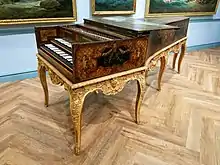Henri Hemsch
Henri Hemsch, original name Johann Heinrich Hemsch (variants Jean-Henri Hemsch, Johannes Heinrich Hembsch) (21 February 1700 – September 1769), was a French harpsichord maker of German origin.

He was born in Kastenholtz, near Cologne, and moved to France in 1728 where he served a six-year apprenticeship in the shop of Antoine Vater, another German émigré. Following this, he set up independently with his younger brother Guillaume (Wilhelm) (b. 5 December 1709; fl. 1748–1774). He served as juré of the instrument makers' guild in 1746. He is considered one of the most important Parisian makers of his time. He was succeeded in his craft by his nephew Jean-Henri Moers (b. Kastenholtz, August 1734; fl. 1754–1793). Five of his double manual harpsichords survive today. The earliest, in the Museum of Fine Arts, Boston, is dated 1736. His instruments are similar to those of Vater and French in style, with two manuals, three-register disposition with shove coupler and a compass of FF–e''' (rising to f''' in a 1761 instrument at the Musée de la Musique, Paris). His remaining instruments are similar in number and quality to those of the Blanchet/Taskin family. He made the famous harpsichord that is now in the Museum of Fine Arts in Boston.
Notes and references
- John Koster: 'Hemsch, Henri [Jean-Henri; Johannes Heinrich Hembsch]', Grove Music Online ed. L. Macy (Accessed 2007-05-18), http://www.grovemusic.com/
